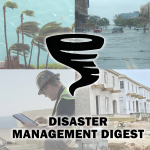Ian housing extended
 La Niña arriving during the upcoming hurricane season might mean wilder waters, temporary housing is extended again to hundreds of Hurricane Ian victims, FEMA reports on its response to last year’s storms and efforts to do better, and why this is the second-best time to prepare for hurricane season. It’s all in this week’s Disaster Management Digest.
La Niña arriving during the upcoming hurricane season might mean wilder waters, temporary housing is extended again to hundreds of Hurricane Ian victims, FEMA reports on its response to last year’s storms and efforts to do better, and why this is the second-best time to prepare for hurricane season. It’s all in this week’s Disaster Management Digest.
La Niña Hurricane Season: An already growing La Niña climate pattern may encourage hurricane development across the Atlantic Basin this storm season, scientists warned in a recent report. This phenomenon is a part of the El Niño-Southern Oscillation, which causes trade winds to shift the flow of warm waters, changing storm forecast and frequency across the Atlantic Basin. Storms gain strength moving across warmer waters, which is a foreboding sign when compounded with the already record high temperatures seen in the hurricane breeding grounds between Africa and the Caribbean. Scientists at NOAA’s Climate Prediction Center said La Niña has a 55% chance of starting up in early summer, and a 74% chance of developing August through October.
 Prepare Now: With less than 100 days left until the official start of hurricane season on June 1, Florida leaders are urging everyone to begin preparing their disaster plans, to make sure they’re ready for the storms that may come. Observed recently on X, this advice from Florida Emergency Management Chief Kevin Guthrie: “The best time to prepare was yesterday, but the second-best time is now. Use these next 100 days to stock your disaster supply kits and make sure you and your loved ones are ready for the season to come.”
Prepare Now: With less than 100 days left until the official start of hurricane season on June 1, Florida leaders are urging everyone to begin preparing their disaster plans, to make sure they’re ready for the storms that may come. Observed recently on X, this advice from Florida Emergency Management Chief Kevin Guthrie: “The best time to prepare was yesterday, but the second-best time is now. Use these next 100 days to stock your disaster supply kits and make sure you and your loved ones are ready for the season to come.”
FEMA Extends Direct Housing: While it’s been 18 months since Hurricane Ian made landfall in September 2022, many Floridians are still suffering the impacts, including hundreds of families still out of their homes. FEMA has announced a six-month extension of the Direct Temporary Housing program through Sept. 29, 2024, for eligible households in Charlotte, Collier, DeSoto, Hardee, Lee, Sarasota and Volusia counties. FEMA, along with the Florida Division of Emergency Management and local partners, continue to help the nearly 700 families still living in temporary housing find a more permanent solution. They are part of the original 1,300 displaced families FEMA helped with temporary housing, with more than 650 families now in a more permanent home. Disaster case managers are also working one-on-one with those survivors to help with their needs. However, after March 29, 2024 many residents will be responsible for paying their own rent, in accordance with FEMA housing program rules.
FEMA Reports Accomplishments: 2023 was quite the year with FEMA responding to 84 presidentially-declared disasters. In its first Office of Response and Recovery Year in Review report, FEMA noted it “implemented new approaches to put people first and remove barriers for disaster assistance.” In 19 recovery missions, FEMA utilized a process that identifies and assists a targeted population of applicants who need proactive assistance navigating the agency’s programs, which it said led to more than $60 million in additional funds for survivors. It also created the first Pre-Disaster Housing initiative to help provide reliable, affordable and safe housing for disaster survivors.
LMA Newsletter of 2-26-24

